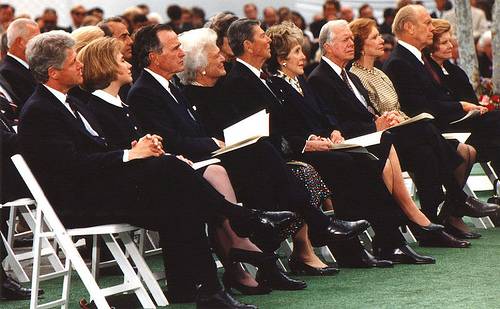Donald John Trump1 (born June 14, 1946) has taken office as the 45th President of the United States on January 20, 2017. Since that day, five former American presidents are alive at the same time.

In the history of the United States there have been only four periods when this was the case:
-
March 4, 1861 - January 18, 1862: Martin Van Buren, John Tyler, Millard Fillmore, Franklin Pierce, James Buchanan
-
January 20, 1993 - April 22, 1994: Richard Nixon, Gerald Ford, Jimmy Carter, Ronald Reagan, George H. W. Bush
-
January 20, 2001 - June 5, 2004: Gerald Ford, Jimmy Carter, Ronald Reagan, George H. W. Bush, Bill Clinton
-
January 20, 2017 - November 30, 2018: Jimmy Carter, George H. W. Bush, Bill Clinton, George W. Bush, Barack Obama
Herbert Hoover lived another 11,553 days (31 years and 230 days) after leaving office. James Polk died only three months (103 days) after leaving his presidency. Of the individuals elected as US President, eight never obtained the status of "former president" because they died in office: William H. Harrison (pneumonia), Zachary Taylor (bilious diarrhea), Abraham Lincoln (assassinated), James A. Garfield (assassinated), William McKinley (assassinated), Warren G. Harding (heart attack), Franklin D. Roosevelt (cerebral hemorrhage) and John F. Kennedy (assassinated).
Assignment
We will process text files that contain information about the lifespan and term of the heads of a particular state. Each line contains five tab-separated information fields: i) name of head of state, ii) birth date, iii) (first) term start date, iv) (last) term end date and v) death date. The four date fields are given in the format dd/mm/yyyy with each fragment being a natural number without leading zeroes: dd indicates the day, mm the month and yyyy the year. The following example shows the contents of such a file that contains information about the last ten Presidents of the United States.
Lyndon B. Johnson 27/8/1908 22/11/1963 20/1/1969 22/1/1973 Richard Nixon 9/1/1913 20/1/1969 9/8/1974 22/4/1994 Gerald Ford 14/7/1913 9/8/1974 20/1/1977 26/12/2006 Jimmy Carter 1/10/1924 20/1/1977 20/1/1981 Ronald Reagan 6/2/1911 20/1/1981 20/1/1989 5/6/2004 George H. W. Bush 12/6/1924 20/1/1989 20/1/1993 Bill Clinton 19/8/1946 20/1/1993 20/1/2001 George W. Bush 6/7/1946 20/1/2001 20/1/2009 Barack Obama 4/8/1961 20/1/2009 20/1/2017 Donald Trump 14/6/1946 20/1/2017
In case a head of state has served multiple non-consecutive terms, we make the assumption that he has served only one consecutive term that runs from the start date of the first term until the end date of the last term. In case the head of state is still serving today, the end date of his term is represented by an empty string. In case the head of state is still alive today, the death date is represented by an empty string. Your task:
-
Write a function heads_of_state that takes the location (str) of a text file that contains information about the lifespan and term of the heads of a particular state. The function must return a dictionary (dict) that maps the names of all heads of state in the file onto a tuple with the dates (datetime.date) of the four events mentioned in the file, in the same order of appearance as in the file. Dates of events that have not yet occurred must be represented by the value None.
-
Write a function retirement that takes two arguments: i) the name (str) of a head of state and a dictionary (dict) that is constructed as the dictionaries returned by the function heads_of_state. If the given name does not occur as a key in the given dictionary, an AssertionError must be raised with the message unknown head of state. Otherwise, the function must return a positive integer (int) that indicates how long the given head of state has enjoyed his retirement. This is computed as the number of days from the end of his (last) term until his death (if the head of state has already died) or until today (if the head of state is still alive). Heads of state that still serve today have not yet enjoyed a single day of their retirement by definition.
-
Write a function alive that takes a dictionary (dict) that is constructed as the dictionaries returned by the function heads_of_state. In addition, the function has an optional parameter reference that may take a reference date (datetime.date). In case no value is explicitly passed to the parameter reference, the function must use today's date as the reference date. The function also has an optional parameter former that takes a Boolean value (bool, default value: False). The function must return a set containing the names (str) of all heads of state in the dictionary that are/were still alive on the given reference date. If the value True is passed to the parameter former, this set has to be restricted to all former heads of state at the given reference date.
Clarification
We consider a person to be president for life (i.e. from his birth until his death, or until today if the person is still alive today) and we consider a person to be former president from the end of his (last) term in office onward.
Tip
All comparison operators (<, >, <=, >=, == and !=) can be applied on datetime.date objects.
>>> import datetime >>> datetime.date(2016, 1, 25) < datetime.date(2017, 1, 25) True
Example
In the following interactive sessions we assume the text file us_presidents.txt2 to be located in the current directory.
>>> events = heads_of_state('us_presidents.txt3')
>>> events['George Washington']
(datetime.date(1732, 2, 22), datetime.date(1789, 4, 30), datetime.date(1797, 3, 4), datetime.date(1799, 12, 14))
>>> events['Barack Obama']
(datetime.date(1961, 8, 4), datetime.date(2009, 1, 20), datetime.date(2017, 1, 20), None)
>>> events['Donald Trump']
(datetime.date(1946, 6, 14), datetime.date(2017, 1, 20), None, None)
>>> retirement('Herbert Hoover', events)
11553
>>> retirement('James K. Polk', events)
103
>>> retirement('Bill Clinton', events)
5820
>>> retirement('Abraham Lincoln', events)
0
>>> retirement('Donald Trump', events)
0
>>> retirement('Donald Duck', events)
Traceback (most recent call last):
AssertionError: unknown head of state
>>> import datetime
>>> alive(events)
{'Donald Trump', 'Jimmy Carter', 'George H. W. Bush', 'Bill Clinton', 'Barack Obama', 'George W. Bush'}
>>> alive(events, former=True)
{'George W. Bush', 'George H. W. Bush', 'Bill Clinton', 'Jimmy Carter'}
>>> alive(events, former=True, reference=datetime.date(2017, 1, 20))
{'George H. W. Bush', 'George W. Bush', 'Jimmy Carter', 'Bill Clinton', 'Barack Obama'}
>>> alive(events, former=True, reference=datetime.date(1861, 12, 31))
{'Martin Van Buren', 'Franklin Pierce', 'Millard Fillmore', 'James Buchanan', 'John Tyler'}
>>> alive(events, former=True, reference=datetime.date(1994, 3, 26))
{'Jimmy Carter', 'Ronald Reagan', 'Gerald Ford', 'Richard Nixon', 'George H. W. Bush'}
>>> alive(events, former=True, reference=datetime.date(2003, 10, 12))
{'Gerald Ford', 'Jimmy Carter', 'George H. W. Bush', 'Bill Clinton', 'Ronald Reagan'}
Epilogue
This is a graphical lifespan timeline of all Presidents of the United States. Forty-four persons have served as President of the United States since the office came into existence in 1789. They are listed in order of office (Grover Cleveland is the only president in American history to serve two non-consecutive terms in office; he is listed in the order of his first presidency).

Former living presidents rarely come together. This happens most often at inaugurations of new presidents. But on October 21st, 2017 the five former presidents Jimmy Carter, George H.W. Bush, Bill Clinton, George W. Bush and Barack Obama came together at a benefit concert to raise funds for the victims of the hurricanes Harvey, Irma and Maria. At the time George H. W. Bush was already suffering from some sort of Parkinson's disease, which confined him to a wheelchair.
